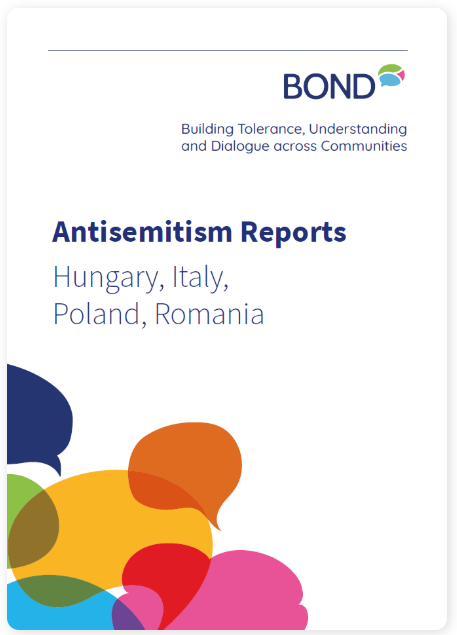
Antisemitism – definitions, categories, history
In order to address a phenomenon, it needs to be defined, so we know what is meant by the term. In defining antisemitism, this document is using the non-legally binding working definition developed by the International Holocaust Remembrance Alliance (IHRA), which has been adopted by all 35 IHRA member states in 2016 and has been adopted by hundreds of institutions since, including governmental institutions, civil society organizations, sports clubs, universities and others.
Definition
IHRA’s non-legally binding working definition of antisemitism:
“Antisemitism is a certain perception of Jews, which may be expressed as hatred toward Jews. Rhetorical and physical manifestations of antisemitism are directed toward Jewish or non-Jewish individuals and/or their property, toward Jewish community institutions and religious facilities.”1
The IHRA provides examples about the potential manifestations of antisemitism: classic and current forms, including the so-called new antisemitism when criticism of the state of Israel becomes antisemitic rather than a real critique of policies. This can be an important resource for guiding the work of professionals, helping them understand what antisemitism is and how many different forms it can take.
Manifestations might include the targeting of the state of Israel, conceived as a Jewish collectivity. However, criticism of Israel similar to that leveled against any other country cannot be regarded as antisemitic. Antisemitism frequently charges Jews with conspiring to harm humanity, and it is often used to blame Jews for “why things go wrong.” It is expressed in speech, writing, visual forms and action, and employs sinister stereotypes and negative character traits.
Examples
Contemporary examples of antisemitism in public life, the media, schools, the workplace, and in the religious sphere could, taking into account the overall context, include, but are not limited to:
- Calling for, aiding, or justifying the killing or harming of Jews in the name of a radical ideology or an extremist view of religion.
- Making mendacious, dehumanizing, demonizing, or stereotypical allegations about Jews as such or the power of Jews as collective — such as, especially but not exclusively, the myth about a world Jewish conspiracy or of Jews controlling the media, economy, government or other societal institutions.
- Accusing Jews as a people of being responsible for real or imagined wrongdoing committed by a single Jewish person or group, or even for acts committed by non-Jews.
- Denying the fact, scope, mechanisms (e.g. gas chambers) or intentionality of the genocide of the Jewish people at the hands of National Socialist Germany and its supporters and accomplices during World War II (the Holocaust).
- Accusing the Jews as a people, or Israel as a state, of inventing or exaggerating the Holocaust.
- Accusing Jewish citizens of being more loyal to Israel, or to the alleged priorities of Jews worldwide, than to the interests of their own nations.
- Denying the Jewish people their right to self-determination, e.g., by claiming that the existence of a State of Israel is a racist endeavor.
- Applying double standards by requiring of it a behavior not expected or demanded of any other democratic nation.
- Using the symbols and images associated with classic antisemitism (e.g., claims of Jews killing Jesus or blood libel) to characterize Israel or Israelis.
- Drawing comparisons of contemporary Israeli policy to that of the Nazis.
- Holding Jews collectively responsible for actions of the state of Israel.
Antisemitic acts are criminal when they are so defined by law (for example, denial of the Holocaust or distribution of antisemitic materials in some countries). Criminal acts are antisemitic when the targets of attacks, whether they are people or property – such as buildings, schools, places of worship and cemeteries – are selected because they are, or are perceived to be, Jewish or linked to Jews. Antisemitic discrimination is the denial to Jews of opportunities or services available to others and is illegal in many countries 2.
Categories
The typology of antisemitism defines various types that educators should be aware of and share with their students or use this knowledge in their teaching about antisemitism.
- Antijudaism or religion-based hatred towards the Jews
- Political antisemitism, which can be racist and even genocidal
- Conspiratorial antisemitism that builds on the belief that some covert but influential Jewish organization is ruling the world or is responsible for a circumstance or event. These conspiracy theories of control and manipulation are still present today, much of contemporary antisemitism remains conspiratorial.
- New antisemitism is a form that manifests in anti-Zionism: the antisemitic hostility against Israel. It does not criticize Israel as a state but questions the legitimacy of its existence and right to defend itself. It also makes all Jews wherever in the world responsible for the acts of Israel as a state.
- Secondary antisemitism is formed along the process of confronting the past and the part individual countries played during the Holocaust. Along this process, Jews ”remind” the majority society of the Holocaust, which builds up guilt and concludes in blaming the Jews.
- Holocaust distortion “reinforces antisemitism (…) as it recirculates age-old antisemitic lies, myths and tropes (…). By promoting such stereotypes and prejudices it incites hatred and opens the door to outright Holocaust denial or other forms of pernicious, dangerous, and violent antisemitism”3 . It does not deny the fact that the Holocaust happened, but minimizes, trivializes, misrepresents or glorifies it and its impact.
1 https://www.holocaustremembrance.com/resources/working-definitions-charters/working-definition-antisemitism
2 https://holocaustremembrance.com/resources/working-definition-antisemitism
3 https://op.europa.eu/en/publication-detail/-/publication/d3006107-519b-11eb-b59f-01aa75ed71a1/language-en/for



Leave a Reply
You must be logged in to post a comment.